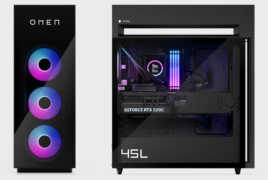Let’s face it: the PC gaming market may not be growing at the breakneck pace it once did, but it still commands extraordinary influence.
Gaming hardware is often the proving ground for technologies that spill over into mainstream consumer and commercial PCs — high-end graphics, advanced cooling systems, immersive audio, and personalization features that redefine user expectations.
HP knows this, and its latest gaming announcement shows the company isn’t treating gaming as a side hustle. Instead, it’s going all-in, fusing design ingenuity with gamer-driven engineering and leveraging its HyperX acquisition to stake a stronger claim in a competitive, if maturing, space.
At the heart of HP’s gaming philosophy is a deceptively simple principle: build based on what gamers say they want. That’s not just marketing rhetoric. HP’s gaming team has organized its roadmap around three pillars that surface repeatedly in its product strategy: performance, personalization, and play.
Every new launch, from flagship desktops to headsets and microphones, ties back to these themes, making the portfolio a coordinated ecosystem rather than a random set of SKUs.
Omen Max 45L Brings Peak Power, Smart Design
HP’s new Omen Max 45L desktop is a statement piece — its most powerful gaming tower to date, and one designed from the inside out with a focus on thermal performance, upgrade flexibility, and aesthetic customization.
Cooling is the headline here, with HP’s patented Cryo Chamber technology making a leap from its first-generation 120mm radiator to a new 360mm liquid cooling system.
Unlike typical designs that recirculate warm case air, the Cryo Chamber is physically isolated at the top of the chassis, pulling in cool ambient air and delivering up to a 7.5-degree Celsius drop in CPU temperatures and a 2-degree drop for the GPU.
HP’s Omen Max 45L gaming desktop showcases triple front RGB fans and a side window view of its GeForce RTX 5090-powered interior with next-gen liquid cooling.
For gamers running high-wattage parts like AMD’s Ryzen 9 9950X3D and Nvidia’s RTX 5090, that’s not a luxury — it’s a performance enabler and a longevity boost.
HP also tackled airflow at the chassis level, strategically placing vents and elevating the case feet to improve intake. The modular 1,200-watt PSU supports cleaner cable management, further aiding airflow, and integrates a novel “fan cleaner” feature that reverses fan direction to dislodge dust on a schedule. These aren’t gimmicks; they’re the kind of engineering touches that experienced gamers and PC builders notice immediately.
Layered on top of the hardware is the Omen Gaming Hub software, which integrates overclocking, thermal control, lighting, and HP’s AI-powered performance tuning. Omen AI applies machine learning to optimize OS, hardware, and in-game settings simultaneously—one-click performance that HP claims can extract maximum FPS in popular titles without manual tweaking.
HP Expands Omen Line for Diverse Gaming Needs
HP is also refreshing its Omen 35L desktop and introducing a “Stealth Mode” variant with the same high-end specs, but stripped of RGB lighting for gamers seeking tournament-level performance in a minimalist package.
This model has already been tapped as the official PC for League of Legends and Valorant esports events, giving HP the kind of credibility that comes from pro-level adoption.
The Omen 16 gaming laptop gets its own boost, now configurable with Nvidia’s RTX 5070 Ti for creators and gamers who need portability without sacrificing rendering horsepower.
HyperX Integration Powers HP’s Gaming Edge
HP’s 2021 acquisition of HyperX is now paying dividends. Rather than treating it as a bolt-on accessory brand, HP is tightly integrating HyperX’s audio, microphone, and peripheral expertise into its gaming strategy, using the same gamer-feedback loop that shapes its PCs.
The new HyperX Cloud Alpha 2 Wireless 3 Headset is a flagship example. With pro-grade, dual-chamber 53mm drivers tuned for both explosive bass and positional accuracy, the Alpha 2 builds on HyperX’s audio pedigree while adding thoughtful upgrades, like simultaneous dual-wireless connectivity, so you can game over 2.4GHz while taking calls over Bluetooth. Battery life is a staggering 250 hours in 2.4GHz mode, roughly double that of competing headsets.
By pairing the HyperX Cloud Alpha 2 Wireless 3 Headset with a customizable RGB control hub, HP is signaling that audio gear is as vital to gaming performance as the PC itself.
A standout innovation is the world’s first reprogrammable RGB base station for a wireless gaming headset. This feature replaces the traditional USB dongle with a desk-friendly control hub that can adjust mic levels, toggle between headset and speakers, and run macros—all customizable in HyperX’s redesigned Ngenuity software.
The Cloud Flight 2 family continues HyperX’s tradition of comfort and durability, now with full RGB panels behind removable earcups for personalization and battery life up to 150 hours on Bluetooth.
HyperX Gear for Streamers and Creators
Recognizing that gaming culture has shifted toward streaming and content creation, HP is leaning on HyperX to deliver professional-grade microphones that are accessible to non-engineers.
The new HyperX Flipcast is a dynamic XLR/USB hybrid microphone that excels at rejecting background noise — ideal for gamers in less-than-ideal acoustic environments. Features like a real-time input meter, tap-to-mute, and on-device EQ filters make it creator-friendly, while dual connectivity allows it to scale from plug-and-play to professional setups.
For newcomers, the SoloCast 2 condenser mic offers clear audio in a simpler package, with a redesigned shock mount, weighted stand, and built-in pop filter — again, the kind of incremental refinement that comes from listening to feedback on previous models.
HyperX SoloCast 2 condenser microphone with built-in stand and USB-C to USB-A cable, designed for clear audio in a compact, creator-friendly package.
From hardware to peripherals, HP’s cohesive approach reinforces its commitment to gaming as a core pillar of its broader strategy.
Why Gaming Still Matters to HP
On paper, the global PC gaming market isn’t expanding dramatically. But HP’s moves show an understanding that gaming remains strategically essential for three reasons.
First, gaming buyers are among the most discerning tech customers. Win them over, and you validate your engineering prowess to a broader audience.
Second, innovations born in gaming — such as AI-assisted performance tuning, advanced cooling, and premium input devices — tend to cascade into non-gaming products, elevating the entire portfolio.
Third, gaming keeps HP visible in cultural spaces that resonate with younger demographics, from esports tournaments to Twitch streams, which helps future-proof the brand.
Design as a Differentiator
HP’s approach also leans heavily on its industrial design capabilities. The Omen Max 45L’s modularity, the Stealth Mode’s understated profile, and the tactile, premium feel of HyperX gear all underscore HP’s belief that form and function aren’t mutually exclusive.
Even playful touches — such as customizing the Omen cooler’s LCD display with GIFs or system stats — add to the visceral sense that HP is designing for lifestyles, not just benchmarks.
In a category where spec sheets often blur together, these kinds of human-centric design details can create real differentiation.
HP’s Long-Term Gaming Strategy
HP’s latest announcements suggest a gaming strategy that is cohesive, deeply integrated across hardware and peripherals, and genuinely informed by user input.
By balancing flagship innovation with practical usability — whether that’s easier upgrades, cleaner cable routing, or software that removes friction — HP is positioning itself as a brand that respects both the performance purists and the everyday gamers who just want their gear to work beautifully.
Analysts widely agree that the global PC gaming market has been relatively stable. Growth rates have hovered around 2% to 4% annually, driven primarily by demand for upgrades rather than new installations.
While overall PC sales have fluctuated, gaming components like GPUs and high-refresh-rate monitors have continued to hold steady market share, thanks to gaming enthusiasts and esports growth.
Given these market dynamics and realities, HP is sending a clear signal that even if the market isn’t on a rocket-ship growth curve, it intends to be one of the companies defining what the next era of gaming hardware looks and feels like.
If history is any guide, much of what HP is pioneering here will find its way into the devices the rest of us use every day.
The images featured in this article are credited to HP.
Source: technewsworld.com




